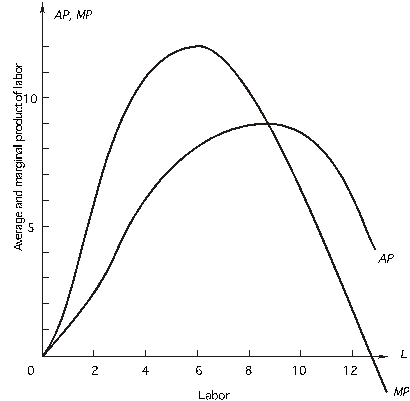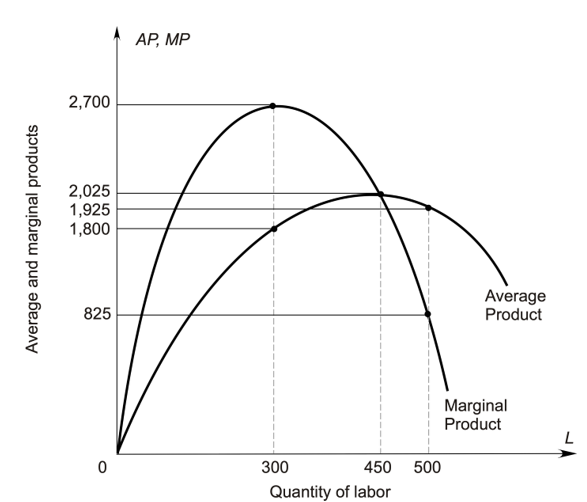A) 100
B) 150
C) 210
D) 360
E) none of the above
G) C) and E)
Correct Answer

verified
Correct Answer
verified
Multiple Choice
out the table and answer the question below. Marginal product is negative when _____ units of labor are employed.
A) 5 units of labor are employed.
B) 6 units of labor are employed.
C) 7 units of labor are employed.
D) both b and c
F) None of the above
Correct Answer

verified
Correct Answer
verified
Multiple Choice
In the table above,what is the marginal product of the fifth unit of labor?
A) 20
B) 50
C) 80
D) -10
E) -30
G) D) and E)
Correct Answer

verified
Correct Answer
verified
Multiple Choice
Given the table below,diminishing returns begin with the
A) 1st worker.
B) 5th worker.
C) 10th worker.
D) 11th worker.
E) 16th worker.
G) A) and C)
Correct Answer

verified
Correct Answer
verified
Multiple Choice
Given the table below,the maximum amount that can be produced using 20 workers is
A) 442 units.
B) 530 units.
C) 22 units.
D) 420 units.
E) 26.5 units.
G) D) and E)
Correct Answer

verified
Correct Answer
verified
Multiple Choice
Marginal cost
A) measures how total cost changes when input prices change.
B) measures how total cost changes when one more unit of output is produced.
C) is less than average cost when average cost is decreasing.
D) both a and b
E) both b and c
G) C) and D)
Correct Answer

verified
Correct Answer
verified
Multiple Choice
 Above is a firm's average product of labor and marginal product of labor curves.The price of labor is $60 per unit.Given this,diminishing returns set in with the
Above is a firm's average product of labor and marginal product of labor curves.The price of labor is $60 per unit.Given this,diminishing returns set in with the
A) 3rd unit of labor.
B) 6th unit of labor.
C) 10th unit of labor.
D) 12th unit of labor.
E) 14th unit of labor.
G) C) and E)
Correct Answer

verified
Correct Answer
verified
Multiple Choice
The capital stock is fixed at 5 units,the price of capital is $60 per unit,and the price of labor is $20 per unit. Based on the above,how much does the 12th unit of output add to the firm's total variable cost?
A) $2.50
B) $4
C) $5
D) $20
E) $40
G) B) and E)
Correct Answer

verified
Correct Answer
verified
Multiple Choice
Based on the following table,the additional cost of producing the 170th unit of output is:
A) $10.50
B) $11.50
C) $13
D) $15
E) none of the above
G) B) and C)
Correct Answer

verified
Correct Answer
verified
Multiple Choice
In the table above,how much does the third unit of labor ADD to total output?
A) 100
B) 125
C) 150
D) 300
E) none of the above
G) A) and D)
Correct Answer

verified
Correct Answer
verified
Multiple Choice
Given the table below,if capital is fixed at one unit,diminishing returns begin with the Amount of total output produced from various combinations of labor and capital.
A) first unit of labor.
B) second unit of labor.
C) third unit of labor.
D) fourth unit of labor.
E) none of the above
G) None of the above
Correct Answer

verified
Correct Answer
verified
Multiple Choice
A firm produces 4,000 units of output using 500 workers.Marginal cost is $10,the wage rate is $160,and total fixed cost is $100,000.When output is 4,000 units,
A) average variable cost is decreasing.
B) average variable cost is increasing.
C) average total cost is decreasing.
D) average total cost is increasing.
E) both a and c
G) A) and D)
Correct Answer

verified
Correct Answer
verified
Multiple Choice
A firm is using a single variable input,labor,with a given amount of a fixed input,capital.If the level of capital is decreased,
A) the total product curve of labor curve shifts downward.
B) the average product curve of labor curve shifts downward.
C) the marginal product curve of labor shifts downward.
D) all of the above
E) none of the above
G) A) and B)
Correct Answer

verified
Correct Answer
verified
Multiple Choice
In the table above,what is the maximum amount of output that can be produced with two workers?
A) 50
B) 125
C) 150
D) 250
E) 320
G) A) and C)
Correct Answer

verified
Correct Answer
verified
Multiple Choice
out the table and answer the question below. The marginal product of the fifth unit of labor is
A) 16.
B) 10.
C) 4.
D) -2.
F) A) and D)
Correct Answer

verified
Correct Answer
verified
Multiple Choice
Suppose that the firm's only variable input is labor.When 50 workers are used,the average product of labor is 50 and the marginal product of labor is 75.The wage rate is $80 and the total cost of the fixed input is $500.What is average total cost?
A) $0.825
B) $0.63
C) $1.80
D) $4.10
E) none of the above
G) D) and E)
Correct Answer

verified
Correct Answer
verified
Multiple Choice
 -Assume labor-the only variable input of a firm-has average and marginal product curves shown in the figure above.The price of labor is $1,000 per unit .At its minimum value,marginal cost is $___________.
-Assume labor-the only variable input of a firm-has average and marginal product curves shown in the figure above.The price of labor is $1,000 per unit .At its minimum value,marginal cost is $___________.
A) $1,000/2,025
B) $1,000/1,925
C) $1,000/1,800
D) $1,000/2,700
E) none of the above
G) A) and E)
Correct Answer

verified
Correct Answer
verified
Multiple Choice
Given the table below,as the number of workers increases from 10 to 15,output per worker
A) increases from 290 to 420
B) increases from 28 to 29
C) decreases from 29 to 28
D) decreases from 30 to 26
E) none of the above
G) C) and E)
Correct Answer

verified
Correct Answer
verified
Multiple Choice
Diminishing returns refers to the decrease in
A) profit that results from increases in output.
B) average total cost that results from decreases in input prices.
C) average product that results from increases in the variable input.
D) marginal product that results from increases in the variable input.
E) long-run average cost that results from increases in output.
G) A) and D)
Correct Answer

verified
Correct Answer
verified
Multiple Choice
In the table below,the capital stock is fixed at 40 units,the price of capital is $15 per unit,and the price of labor is $80 per unit. If the firm produces 180 units of output,what is total variable cost?
A) $1,200
B) $1,800
C) $14,400
D) $17,100
E) none of the above
G) All of the above
Correct Answer

verified
Correct Answer
verified
Showing 41 - 60 of 107
Related Exams